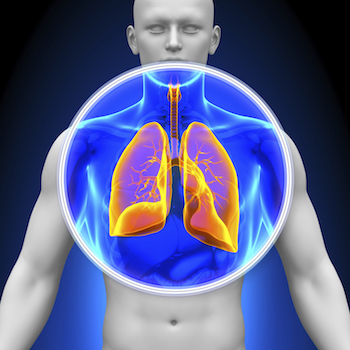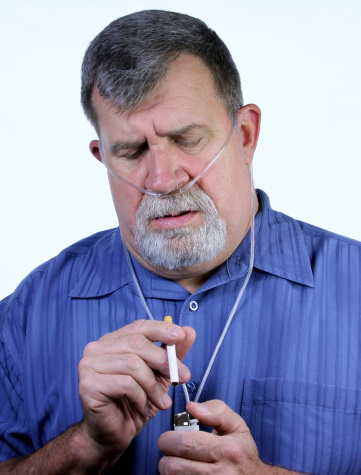Stay Informed
Popular Articles
- Hiatal Hernia: Hidden Cause of Chronic Illness
- Small Intestinal Bacterial Overgrowth (SIBO)
- Applied Lymphology: Unlocking the Secret to Pain Relief
- An Introduction to Constitutional Iridology
- The Low Down on Liver Detoxification
- An Energetic and Emotional Approach to Cancer
- Fat Facts
- Marrow in the Bones
- Blood Type and Nutrition
- Cardiac Herbs: Beyond Hawthorn
Quick Search
The School of Modern Herbal Medicine




Natural Strategies for Preventing and Treating COPD and Asthma
- 5/14/2015
- Categorized in: Specific Health Problems
 Most of us are fortunate enough to take breathing for granted, but millions of people struggle to breathe due to chronic respiratory problems. COPD (chronic obstructive pulmonary disorder) is the medical term used to describe these disorders, which include chronic bronchitis, emphysema and severe bronchiectasis. Asthma is also considered a COPD, but is usually addressed separately. All of these diseases make it difficult to breathe and generally involve blockage in the air passages, bronchial muscle spasms, inflammation of the mucus membranes, deterioration of the lung tissue and increased mucus production.
Most of us are fortunate enough to take breathing for granted, but millions of people struggle to breathe due to chronic respiratory problems. COPD (chronic obstructive pulmonary disorder) is the medical term used to describe these disorders, which include chronic bronchitis, emphysema and severe bronchiectasis. Asthma is also considered a COPD, but is usually addressed separately. All of these diseases make it difficult to breathe and generally involve blockage in the air passages, bronchial muscle spasms, inflammation of the mucus membranes, deterioration of the lung tissue and increased mucus production.
According to the Centers for Disease Control (CDC), 18.9 million Americans suffer from asthma, and another 15 million suffer from COPD. Doctors typically treat these people with synthetic anti-inflammatories, bronchial dilators, antihistamines, expectorants and decongestants. They may also use antibiotics, respiratory therapy, and even surgery. These medical treatments may relieve symptoms and even save lives, but they cannot cure these diseases. In fact, many medical practitioners consider these diseases to be incurable.
Understanding Asthma
Asthma is characterized by wheezing, coughing, shortness of breath and tightness in the chest. These symptoms occur because airways become constricted, making it difficult to breathe. Two factors are involved. The first is inflammation. Various irritants, such as air pollution, pet and animal dander, dust mites, mold, infections, pollen or even foods, trigger inflammatory reactions in the air passages. This causes swelling of the airways, which inhibits breathing. Doctors typically treat this with oral or inhaled corticosteroid drugs that reduce the inflammation.
The second factor in asthma is a constriction of the airways due to muscular contraction or stress. Epinephrine, which is released by the sympathetic nervous system, causes dilation of the air passages, while the parasympathetic nervous system causes air passages to constrict, reducing airflow. Modern medicine typically treats this with inhalers that contain epinephrine and cause immediate bronchial dilation. Both of these approaches to asthma can be duplicated with natural remedies, but they are merely band-aids because they don’t heal the asthma. We’ll discuss strategies that fix the root causes of the inflammation and vasoconstriction later in this article.
Understanding COPD
 COPD is characterized by chronic cough (also known as smoker’s cough), chronic phlegm production, shortness of breath while doing routine things, wheezing, and inability to breathe deeply. COPD has some similarities with asthma, but there are some additional issues. In COPD, the bronchial tubes also become inflammed and swollen, but there can be damage to the air sacs in the lungs that causes them to break down, resulting in less surface area for oxygen exchange. These tissues may also lose their elasticity. The cilia, which sweep mucus out of the lungs, may also become less effective, causing mucus to accumulate in the airways amd further inhibit breathing. These factors can make exhalation as well as inhalation difficult.
COPD is characterized by chronic cough (also known as smoker’s cough), chronic phlegm production, shortness of breath while doing routine things, wheezing, and inability to breathe deeply. COPD has some similarities with asthma, but there are some additional issues. In COPD, the bronchial tubes also become inflammed and swollen, but there can be damage to the air sacs in the lungs that causes them to break down, resulting in less surface area for oxygen exchange. These tissues may also lose their elasticity. The cilia, which sweep mucus out of the lungs, may also become less effective, causing mucus to accumulate in the airways amd further inhibit breathing. These factors can make exhalation as well as inhalation difficult.
Like asthma, COPD may be treated with bronchial dialators and anti-inflammatories, but oxygen therapy and surgery may eventually be required. Again, we’ll discuss how to work on the root causes of COPD and help the lungs to actually heal later.
A Concise Owner’s Manual for Your Lungs
When you inhale, air enters your nose and/or mouth and travels down to the trachea and into the two bronchial passages in the lungs. The bronchial passages are like the trunks of an upside-down tree that divides into smaller and smaller tubes called bronchioles. These bronchioles end in tiny air sacks called alveoli. Each alveoli is surrounded by a blood capillary, allowing the exchange of oxygen and carbon dioxide to take place.
The lungs themselves are fairly passive. Their spongy texture allows them to expand and contract as the diaphragm and rib muscles alter the size of the chest cavity. The alveoli are elastic, like tiny air balloons. As the diaphragm contracts downward and the chest expands outward, they inflate. As the diaphragm and chest muscles relax, the alveoli contract, pushing air out of the lungs.
Since the air you breathe can contain dust, pollen, bacteria, viruses and other debris, the membranes lining the respiratory passages from the sinuses to the lungs secrete a thin, watery substance called mucus to coat and protect them. This mucus traps particles, and tiny hair-like cilia sweep the mucus (and the debris it traps) away. Mucus in the s
inus cavities is pushed to the back of the throat, while mucus in the lungs is swept to the trachea and into the esophagus.
Avoiding Respiratory Irritation
With this basic understanding, we’re now ready to explore the underlying causes of asthma and COPD. It is well established that both conditions can be linked to triggers that irritate and inflame the lungs, such as:
- Tobacco smoke (primary and second-hand)
- Pollen
- Respiratory infections
- Cold, dry air or hot, humid air
- Chemical irritants (such as smoke, smog, pain fumes, artificial fragrances)
- Pet and animal dander
- Mold, fungus and dust mites
Most cases of emphysema are caused by cigarette smoking, while the remaining cases are caused by exposure to other irritants. So, one of the first things needed to both prevent and treat COPD is to mimimize exposure to these irritants. If you smoke, quit. If you work around chemicals like solvents or paint, be sure to wear appropriate protective equipment. Also use non-toxic household cleaning products and personal care products.
 People living in cities with high levels of air pollution are at a greater risk for developing asthma and other lung problems. If you live in an area with high levels of air pollution and can’t move, consider getting an effective air filtration system for your home. These systems can help reduce particulate matter in the air and are helpful in eliminating mold, bacteria, viruses and other airborne contaminants.
People living in cities with high levels of air pollution are at a greater risk for developing asthma and other lung problems. If you live in an area with high levels of air pollution and can’t move, consider getting an effective air filtration system for your home. These systems can help reduce particulate matter in the air and are helpful in eliminating mold, bacteria, viruses and other airborne contaminants.
Supporting Respiratory Detoxification
When most people have excessive mucus drainage (sneezing, coughing and post-nasal drip) they want to do something to make it stop. They take antihistamines, cough suppressants and other remedies to dry up or arrest this drainage. However, this flushing of irritants with mucus is how the respiratory system cleanses itself of irritants. When this process is interfered with, irritants remain in contact with lung tissue for longer periods of time, which increases lung irritation, creating chronic inflammation and eventually tissue damage.
So, instead of fighting this process, it’s best to support it. Avoid using antihistamines and cough suppressants when congested. Instead, drink plenty of fluids to keep the mucus thin (mucus is mostly water). Take decongestant herbs to loosen mucus and expectorant herbs to help the body expel the mucus from the body (see Expectorants and Decongestants further down).
Dehydration aggrevates respiratory problems, so if you have asthma or COPD avoid beverages that increase water loss such as coffee, tea, caffienated sodas and alcohol. Drink one-half ounce of pure water per pound of body weight daily.
The Respiratory-Gut Connection
It is well documented that children who are raised in sterile, city environments tend to have more problems with allergies and asthma than children who are raised around animals and dirt. This may have to do with the importance of gut microflora to respiratory health. When the gastrointestinal tract is irritated and inflamed, this can increase the sensitivity of the respiratory membranes, causing increased lung and sinus problems. Therefore, cleansing and healing the gastrointestinal tract and establishing a healthy population of intestinal microflora is essential to a healthy respiratory system.
Natural Remedies to Help You Breathe Freely
There are many natural remedies that can help a person with COPD or asthma to breathe freely. We’ll first look at natural alternatives to medical treatments for symptomatic relief. Then we’ll discuss remedies that can work on the root causes for a more permanent solution.
Reducing Inflammation
Corticosteroids are frequently used to treat COPD and asthma. These drugs are used to reduce inflammation and mimic the action of a hormone called cortisol produced by the adrenal glands. Corticosteroids are administered orally and via inhalation to rapidly reduce inflammation and ease breathing. However, they also have numerous side effects, including elevated blood pressure, weight gain, elevated blood sugar levels, suppression of the immune system, and gastrointestinal upset.
Fortunately, there are natural ways to reduce inflammation. First, since inflammation is the body’s natural response to irritation, avoid substances that irritate the mucus membranes. This includes not only the inhaled irritants listed previously, but irritants that are ingested.
 Many people with chronic respiratory diseases find improvement when they eliminate dietary allergens such as grains (especially the gluten-bearing grains like wheat, rye and barley), dairy products, food additives and preservatives, and refined sugars. It is also important to avoid any foods that tend to produce intestinal gas, bloating, burping or belching, as these are feeding small intestinal bacteria and causing gastrointestinal tract (GI) upset.
Many people with chronic respiratory diseases find improvement when they eliminate dietary allergens such as grains (especially the gluten-bearing grains like wheat, rye and barley), dairy products, food additives and preservatives, and refined sugars. It is also important to avoid any foods that tend to produce intestinal gas, bloating, burping or belching, as these are feeding small intestinal bacteria and causing gastrointestinal tract (GI) upset.
Strengthening the adrenals can help the adrenal glands to produce natural cortisol to help regulate inflammation. Licorice root has a cortisol-sparing action and helps reduce chronic inflammation. It also helps reduce cravings for sugar. It is a good choice for asthmatic children, but may be problematic for adults with COPD if they have high blood pressure. A good Adrenal Tonic Formula can strengthen the adrenal glands and prove very helpful for adults with COPD.
Dilating the Bronchials
Emergency inhalers deliver a dose of ephinephrine to the bronchial passages, causing them to dilate and allow more air to enter the lungs. This can be life saving for a person in the middle of an asthma attack, but these drugs also have side effects when used long term. Ephinephrine tends to raise heart rate and blood pressure and increases feelings of stress and anxiety.
An herbal alternative to this is lobelia. Lobelia contains an alkaloid called lobeline. Lobeline dilates the bronchials, but it lowers blood pressure and heart rate, reducing stress and anxiety. Taking a small amount of lobelia (20-30 drops) several times a day can help keep air passages open. It can also be used in an emergency to stop an asthma attack. Take 20-30 drops every 2-3 minutes with water until the attack subsides. Large doses of lobelia can cause nausea and induce vomiting, but this rarely happens when it is taken in this manner.
Balancing Immune Reactions
As mentioned previously, there is a big connection between the health of the gastrointestinal tract and the respiratory tract. Most people with chronic respiratory problems have digestive problems such as a hiatal hernia, leaky gut and/or small intestinal bacterial overgrowth (SIBO), so it may be helpful to work on improving the health of the GI tract.
Most asthmatics and COPD sufferers have a hiatal hernia, a condition where the stomach slides upward into the opening in the diaphragm for the esophogus. This creates a mechanical obstruction that inhibits deep breathing from the diaphragm. For help with correcting a Hiatal Hernia, go to http://modernherbalmedicine.com/articles/video-demonstrations-on-identifying-and-correcting-a-hiatal-hernia-2.html.
 It is also common for people with chronic respiratory problems to have poor digestion, especially of protein. Consider using a Digestive Tonic Formula, Digestive Bitter Tonic Formula, or a supplement containing hydrochloric acid to improve digestion. This also helps to control bacteria in the small intestines and ease gas and bloating. A colon cleanse using a Stimulant Laxative Formula may also be helpful, followed by regular use of a Gentle Laxative Formula to tone intestinal membranes and support the respiratory system.
It is also common for people with chronic respiratory problems to have poor digestion, especially of protein. Consider using a Digestive Tonic Formula, Digestive Bitter Tonic Formula, or a supplement containing hydrochloric acid to improve digestion. This also helps to control bacteria in the small intestines and ease gas and bloating. A colon cleanse using a Stimulant Laxative Formula may also be helpful, followed by regular use of a Gentle Laxative Formula to tone intestinal membranes and support the respiratory system.
As discussed earlier, a healthy balance of intestinal flora helps modulate immune responses and can be very helpful for easing allergies, asthma and COPD. Probiotics contains various strains of friendly bacteria to help reestablish a healthy intestinal flora. It can also be helpful to eat naturally cultured vegetables, such as raw saurkraut or Kim chi.
Two herbs that help to modulate immune reactions and may be helpful for COPD and asthma are cordyceps and astragalus. Both of these herbs are very healing to the lung tissue as well.
Healing Lung Tissue
In COPD lung tissue may be severely damaged. The damaged tissue means there is less surface area for oxygen exchange making breathing difficult. The lung tissue may also have lost elasticity and mucus may accumulate in the lung tissue, further inhibiting airflow. Drugs can’t accomplish this, but good nutrition and herbal remedies can help.
 Start by eating a diet consisting primarily of fresh fruits and vegetables. Include good quality proteins such as 100% grass-fed beef, lamb or buffalo, organic chicken, pasture-raised chicken eggs, deep ocean fish, wild-caught salmon, or wild game. Also use healthy fats such as organic butter, coconut oil, olive oil, avocados and nuts.
Start by eating a diet consisting primarily of fresh fruits and vegetables. Include good quality proteins such as 100% grass-fed beef, lamb or buffalo, organic chicken, pasture-raised chicken eggs, deep ocean fish, wild-caught salmon, or wild game. Also use healthy fats such as organic butter, coconut oil, olive oil, avocados and nuts.
Herbs that can help include mullein, marshmallow, and horsetail. Mullein is a gentle remedy that helps hydrate and heal lung tissue. Take 6-8 capsules daily for 6-12 months. Where lungs have lost elasticity or blood is being coughed from the lungs, horsetail can be helpful. It helps to restore elasticity to tissues and tones them up to stop bleeding. In this case take 2-4 capsules for 3-6 months, as this is also a slow-acting nutritive remedy.
A good Moistening Lung/Cough Formula can be very helpful for COPD. These blends are designed for shortness of breath, chronic dry cough, wheezing and other symptoms associated with COPD. They can also help in healing lung tissue, preventing infection, and improving pulmonary function. They are especially useful for people who live in climates where the air is very dry, as it helps to hydrate the lungs.
 In cases of asthma, consider using a Lung and Respiratory Tonic Formula or a Decongestant and Bronchialdilator Formula. These can help “ventilate” the lungs by expelling mucus, dilating the bronchials, and reducing respiratory inflammation. This can be even more effective if you take 10-15 drops of Lobelia essence with the formula.
In cases of asthma, consider using a Lung and Respiratory Tonic Formula or a Decongestant and Bronchialdilator Formula. These can help “ventilate” the lungs by expelling mucus, dilating the bronchials, and reducing respiratory inflammation. This can be even more effective if you take 10-15 drops of Lobelia essence with the formula.
Where mucus is thick and trapped, try taking yerba santa, grindelia (gumweed) and/or plantain along with an Expectorant and Bronchialdilator Formula. For combating respiratory infections, combine your formula with a garlic supplement or colloidal silver.
Additional Help and Information
For more information on natural approaches to COPD and asthma, consult the following sources:
The Comprehensive Guide to Nature’s Sunshine Products by Tree of LightNatural Therapies for Emphysema and COPD by Robert J. Green, ND
Breathe Free by Daniel Gagnon and Amadea Morningstar
Hiatal Hernia Resources: www.modernherbalmedicine.com/articles/hiatal-hernia-hidden-cause-of-chronic-illness-2.html, www.youtube.com/watch?v=hrdNfaanpIs and www.youtube.com/watch?v=xX0zKB2_-UM
